
Going to start cold email outreach and wondering what you need to do for email warmup?
Email warmup is essential for building a robust sender reputation and ensuring your messages don’t end up in the spam folder. This careful, strategic approach helps to foster trust, signaling that the sender is genuine and the content is what the recipients desire.
Let’s dive into our discussion on effective email warmup techniques and discover how to turn every cold outreach into a warm welcome in every recipient’s inbox.
Email warmup is a crucial process in cold email marketing. It helps you build and establish a reputable sender reputation with email service providers (ESPs). This process involves gradually increasing the number of emails a new account sends over time, thereby demonstrating to ESPs that the sender is legitimate and trustworthy.
Email warm-up for your cold email campaigns can help you –
A well-executed email warm-up strategy directly impacts deliverability in several ways. Firstly, it helps avoid immediate red flags from automated spam filters that you will trigger from sudden sending activity spikes. Avoiding these triggers will ensure that your emails are more likely to land in the inbox by avoiding the spam folder.
Because of email warmup, your sending volume increases without significant issues like high bounce rates or spam complaints, and your sender score improves. This high sender score increases the likelihood that your emails successfully go to the recipient’s inboxes.
Sender reputation is a dynamic score that ESPs assign to your domain based on several factors, including, but not limited to, the volume of emails sent, the number of bounces, the rate of emails marked as spam, and engagement rates such as opens and clicks.
When you begin your email campaign with a warm-up phase, you’re effectively demonstrating to your ESP that your email-sending habits are for engaging rather than annoying. These positive interactions increase your sender reputation with the ESPs.
A solid sender reputation has a direct correlation with your campaign’s visibility. If your ESP trusts your sending patterns and the quality of your interactions, your emails will face fewer filters and roadblocks, thus ensuring better delivery rates.
The core of improving open rates through email warm-up lies in the cultivation of sender credibility. A positive interaction pattern established during the warm-up phase significantly influences how ESPs handle your future emails.
Moreover, when your emails consistently reach the inbox, recipients are more likely to recognize and open them. The psychological aspect of seeing an email in the primary inbox versus the spam folder is stark; emails perceived as legitimate command more attention and action.
Therefore, a carefully managed warm-up phase not only boosts your sender reputation but also persuades your target audience to expect and engage with your messages.
Here is a closer look at the essential elements affecting your email warmup phase.
Duration of Email Account Ownership: Newer accounts get a check more closely than well-established ones, as spammers frequently create and use new accounts for malicious activities. Longer-owned accounts that have been active without issues are more likely to be trusted by email service providers.
Quality and Integrity of the Email List: The health and quality of your email list are vital. High-quality lists with low bounce rates and few spam reports are crucial for a successful warmup process. Regularly cleaning your list to remove inactive or unresponsive addresses can also help maintain its integrity.
Degree of Personalization in Email Communications: Personalization goes beyond merely inserting the recipient’s name in the email. It involves tailoring the content to meet each recipient’s specific needs and interests based on the data you’ve collected. Personalized emails are more likely to engage recipients and elicit positive responses.
Consistency and Frequency of Email Engagement: How often and regularly you send emails during the warmup process can significantly impact your sender reputation. Consistently engaging with your audience at a reasonable frequency (not too sporadic and not too frequent) helps establish a pattern of reliability and trustworthiness.
The time it takes to warm up an email address effectively can vary. However, a typical warm-up period lasts about 2-3 weeks. During this time, the focus should be on sending emails to recipients who are likely to engage positively by opening, reading, and responding to your emails.
Warming up your email address lays a solid foundation for successful email marketing campaigns.
We will look into a comprehensive guide for cold email warmup in both manual and automated ways to give you better insights into the relevant processes.
First, let’s look at how you can manually do the email warm-up process.
The whole process begins with establishing a professional presence that reassures your recipients of your authenticity. The first step in your email setup is choosing a domain that accurately reflects your brand identity. Opt for a custom domain, such as @yourcompanyname.com, rather than a generic email provider like @gmail.com.
You can easily get the custom domain with workspace accounts from email service providers, such as G-Suite accounts from Gmail. It adds a layer of professionalism and instills trust in your recipients, signalling that your cold emails are from a legitimate business entity.
After securing your domain, it’s important to focus on the personalization aspects of your email account. Start by incorporating a profile picture that aligns with your brand. It could be your company logo or a professional headshot if the emails are going from an individual’s email account.
Crafting a detailed email signature is the next essential step in this process. Your signature should include your full name, position, contact information, and links to your company’s website and social media profiles, if applicable.
Email authentication is critical in setting up a successful cold email campaign. It involves validating your email domain through various technical standards that help maintain email security and increase deliverability.
The 3 main protocols in email authentication are – Sender Policy Framework (SPF), DomainKeys Identified Mail (DKIM), and Domain-based Message Authentication, Reporting & Conformance (DMARC).
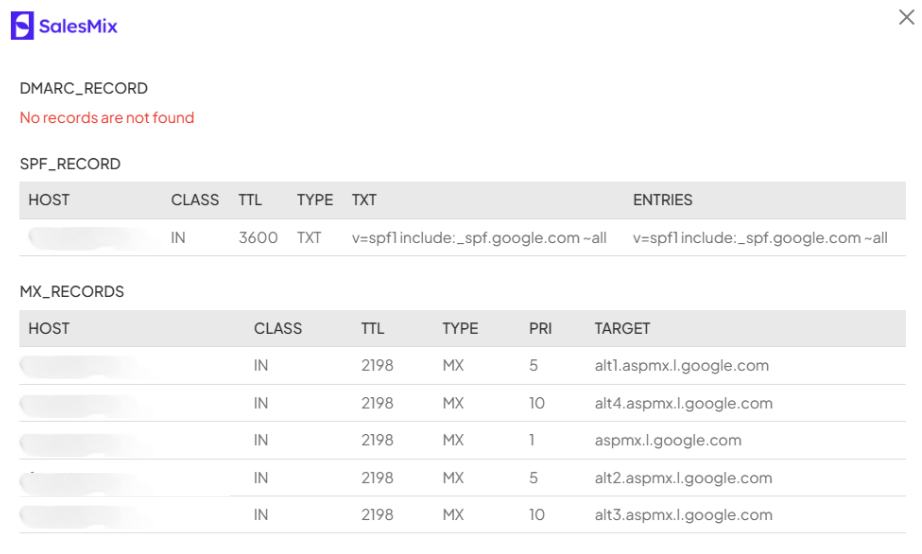
Email authentication in SalesMix
Sender Policy Framework (SPF): SPF is an email authentication method designed to prevent spammers from sending messages on behalf of your domain. This protocol allows you to specify which mail servers are permitted to send email on behalf of your domain.
To implement SPF, you need to add an SPF record to your domain’s DNS settings. This record lists the servers that have authentication to send emails on behalf of your domain.
Domain Keys Identified Mail (DKIM): DKIM provides a way to validate a domain name identity associated with a message through cryptographic authentication. It attaches a digital signature linked to your domain to each outgoing email. When receiving servers get the email, they check this signature by looking up your DKIM record in the DNS.
Setting up DKIM involves generating a pair of cryptographic keys – one private and one public. The private key stays secure with you, while the public key is published in your DNS as a DKIM record. Email systems that use DKIM verify the email signature with the public key. If the verification is successful, it builds trust in the integrity of the sender.
Domain-based Message Authentication, Reporting & Conformance (DMARC): DMARC leverages the power of both SPF and DKIM. It allows domain owners to inform ESPs how to handle emails that fail SPF and DKIM checks. It also provides a way for the email receiver to report back to the sender about emails that pass and/or fail DMARC evaluation.
To implement DMARC, you need to publish a DMARC record in your DNS. This record tells receiving email servers how to enforce SPF and DKIM failures – whether to reject, quarantine, or let them pass with a report. The policy you choose depends on how aggressive you want to be in your email authentication stance.
A practical approach to kickstart the email warmup process is manually sending emails to known contacts. It can include current clients, colleagues, or friends who are already familiar with you and your business.
The key during this initial phase is to keep your emails casual and conversational. The objective is not to sell but to engage. These first emails should foster interactions, such as replies or forwarding, which are positive indicators to email service providers (ESPs) that recipients welcome your emails.
It’s beneficial to send these initial emails to various ESPs like Gmail, Yahoo, and Outlook. Diversifying the ESPs that handle your emails helps establish broad credibility. Each provider has its own set of spam filters, and sending practices to diverse ESPs aid in building a robust sender profile across a wider network.
However, it’s essential to remain cautious and thoughtful about whom you’re emailing. While the urge might be to reach out to as many new contacts as possible, it’s important to avoid emailing complete strangers during this phase.
As you initiate your email outreach, the content of each email should be engaging, relevant, and valuable to your recipients. This focus is vital for maintaining a good sender reputation.
High-quality content in cold emails often addresses the recipient’s potential needs or interests without overtly selling right from the start. Initial emails could include insights about your industry, updates about your business that provide value, or even personalized content that speaks directly to the recipient’s business challenges or goals.
Timing your emails correctly is equally important. Sending emails at a time when recipients are most likely to be checking their inboxes can significantly increase open rates.
The rationale behind this controlled increase in email volume is to build trust with ESPs gradually. Sudden spikes in email activity can often feel like spam-like behavior, potentially leading to blacklisting or lowered sender scores.
During this phase, it is essential to monitor the reactions to your emails closely. You should pay attention to key metrics such as open rates, click rates, and, most importantly, the rate of complaints or unsubscribes. These indicators will guide you on whether your current volume is well-received or adjustments are necessary.
This warmup phase focuses on nurturing the initial contacts into ongoing dialogues. It can be pivotal in enhancing both the campaign’s effectiveness and the sender’s reputation.
When you begin to receive replies to your cold emails, sustaining these interactions with thoughtful and personalized responses should be prioritized. This ongoing engagement demonstrates to ESPs that your communications offer value to recipients, which supports your credibility and helps maintain your email inbox placement.
A crucial aspect of any successful cold email campaign is managing the timing of your emails. This strategy is integral to building and preserving a positive sender reputation while avoiding overwhelming recipients.
The practice of scheduling intervals between emails serves multiple purposes. Primarily, it respects the recipient’s space and time, allowing them to process and respond to each message without feeling any rush.

Set time interval between cold emails in SalesMix
Moreover, by spacing out your emails thoughtfully, you create a rhythm in your communication to help establish familiarity and anticipation in your recipients. When emails are expected but not incessant, recipients are more likely to engage positively with the content.
An innovative approach to enhancing your cold email warmup process involves subscribing to relevant newsletters within your industry. It will increase the number of legitimate emails you receive in your warmup inbox and the number of times you interact with them.
This tactic signals to email service providers (ESPs) that your email account is active and engaging with relevant professional content, thereby improving your account’s credibility. When you reply to these newsletters thoughtfully, you demonstrate consistent and genuine engagement, further solidifying your reputation as a valid user.
The concept behind a pilot email campaign is to target a select group of recipients representing your larger target market. This group should be diverse enough to grasp meaningful feedback but small enough to manage adjustments and monitor interactions closely.
You should focus on the quality of engagement rather than the quantity. You need to monitor how recipients interact with your emails – are they opening them? Are they clicking on links? Are you getting any responses from the recipients? This feedback is invaluable as it reveals what’s working and what isn’t.
Additionally, this phase allows you to fine-tune your technical setup. It’s a practical test to ensure your SPF, DKIM, and DMARC records have proper configuration, which is critical for email deliverability. You can resolve any issue you encounter during the pilot without the risk of harming your reputation on a larger scale.
As you approach the launch of your full-scale cold email campaign, thorough preparation is essential to ensure that all the groundwork laid during the warmup phase translates into success.
First and foremost, you should review the data collected from your pilot email campaign. It includes analyzing open rates, click-through rates, response rates, and any feedback received from recipients.
You have to identify which elements of your emails performed well and which could be improved. Perhaps certain subject lines garnered more attention, or specific types of content led to higher engagement. Use this information to refine your email templates and targeting strategy.
You should also review it to see if the timing of the cold emails is working. Finally, look over all the technical aspects of your campaign again to ensure they are in order. You should also ensure your email list is clean and up-to-date and remove inactive or unresponsive contacts.
Automating the email warm-up process is a game-changer for marketers and sales reps looking to streamline their cold email campaigns efficiently. This process becomes more systematic and less prone to human error with specialized tools.

Automated Email Warm-Up in SalesMix
The beauty of using automated email warm-up tools for this purpose lies in their ability to manage multiple aspects of email engagement without manual intervention. For example, they can ensure that your emails are going at optimal times and are interacting in a way that signals to ISPs that your correspondence is valuable to recipients.
Choosing the right email warmup tool for cold email campaigns involves understanding the features that can optimize your sender reputation and ensure your emails consistently land in the inbox.
Ease of Setup
Compatibility with Various Email Providers
Unlimited Email Warming
Affordable Pricing
Detailed Analytics
Multiple Email Connections.
Automation
Human-Like Sending Variable Generation
Peer-to-Peer Interaction.
Enhanced Deliverability and Engagement
We will now go through some of the best practices for email warmup.
Not replying to all emails at once can help you build a positive relationship with ESPs and avoid any red flags related to spam or automated behavior. Responding to emails individually and over time mimics the typical behavior of a regular email user, which ESPs monitor to determine the legitimacy of email accounts.
Personalization in email content goes beyond just addressing recipients by their first names. It involves tailoring the content to meet each recipient’s specific needs, interests, and characteristics.
Personalized emails are less likely to get spam flags as well. Recipients recognize the effort put into addressing their specific needs. They will more likely interact positively with the email, such as replying or clicking through on links.
While links are valuable tools for directing recipients towards additional resources, engaging content, or call-to-action destinations, overloading an email with too many links can raise red flags with ESPs. They will feel like spam or phishing attempts to the ESPs.
A high number of links can also overwhelm recipients. When an email has many links, it can detract from the main message or call to action.
Choosing the right Email Service Provider (ESP) is a foundational decision in the success of your cold outreach. It influences how effectively you can manage your emails and your campaigns’ deliverability and overall performance.
You should look into the following aspects while evaluating the ESP for you:
Deliverability
Usability and Features
Integration Capabilities
Customer Support
Scalability
Compliance and Security
Carefully selecting an ESP that meets these criteria sets the stage for a successful email warmup and builds a strong foundation for future cold email marketing.
When overused, multimedia elements in emails can trigger spam filters. Many email service providers scrutinize emails with a high image-to-text ratio, as spammers commonly use images to evade text-based filters.
Emails laden with graphics and videos tend to have larger file sizes. It can slow down the loading time for recipients, especially those accessing their email on mobile devices or areas with limited internet bandwidth.
Spam filters react to keywords frequently abused in phishing scams, overly aggressive marketing, or outright spam attacks. Words that imply exaggerated urgency, incredible promises, or aggressive sales language, such as “guaranteed,” “risk-free,” “instant,” “Buy now,” “Order today,” or “Don’t miss out” can raise spam flags.
The presence of an unsubscribe link in your emails provides recipients with a straightforward way to opt out of future communications. It can significantly reduce the likelihood of your emails being marked as spam.
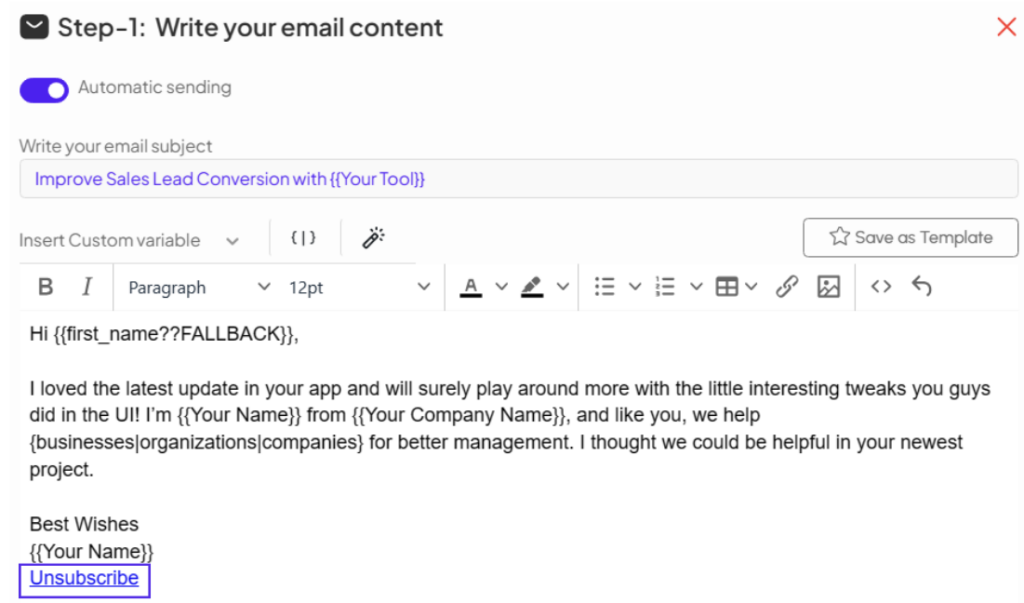
Include an Unsubscribe Link with SalesMix
Monitoring email engagement involves analyzing various key metrics such as open rates, reply rates, unsubscribe rates, etc. Each of these metrics offers insights into different aspects of your email performance.
For instance, a low open rate might suggest your subject lines do not effectively capture interest. In contrast, a high unsubscribe rate could indicate that your content is too frequent or not resonating with your audience. Qualitative feedback, such as direct replies from recipients, can also provide deeper insights into how your audience perceives your emails.
The process of testing deliverability involves sending out test emails to accounts that you know across various email service providers (ESPs) like Gmail, Yahoo, and Outlook. It allows you to see firsthand whether your warm-up emails are landing in the inbox, spam folder, or not being delivered at all.
Observing where your emails end up can give you insights into how different ESPs treat your emails and whether any aspects of your emails – such as content, formatting, or header information -might trigger spam filters.
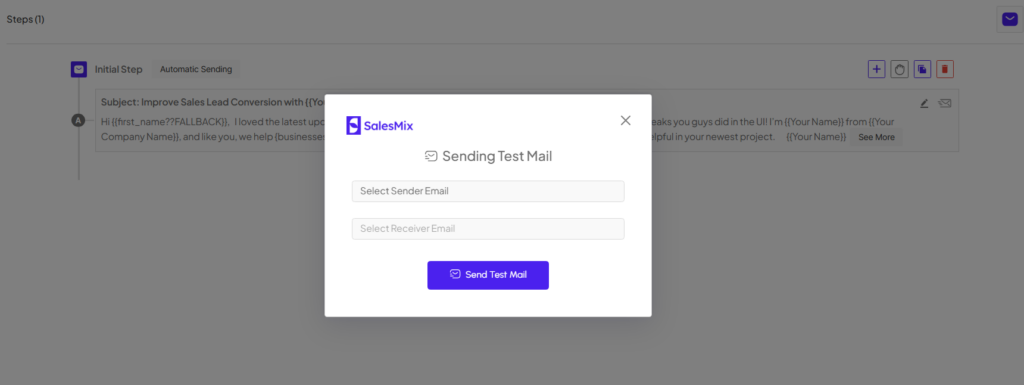
Test your warmup email with SalesMix
The culmination of effective email warmup practices doesn’t reach the initial success of your campaigns but rather through the continuous review and optimization of your strategies. Continuous review involves regularly assessing the performance of your email campaigns against your set goals.
Optimization, on the other hand, is about taking these insights and turning them into actionable improvements. It can mean tweaking your email copy, adjusting the frequency of your emails, segmenting your list more effectively, or refining your ove
SalesMix simplifies the email warmup process and enhances your overall email deliverability. It offers seamless integration capabilities with all major email providers, like Gmail, Zoho, etc. This universal compatibility ensures that regardless of the email service you use, SalesMix can effectively manage and improve your sender reputation.
Connect your email account in SalesMix
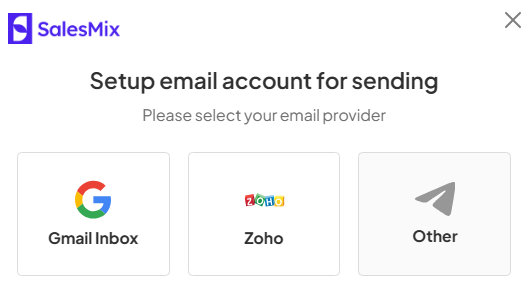
Add any ESP for warmup in SalesMix.
What sets SalesMix apart is its ability to automate the entire process with just a single click. Once set up, the tool methodically increases the volume of emails sent, ensuring that this escalation mimics genuine human interaction, which is crucial for building trust with Internet Service Providers (ISPs).
You also get unlimited email-warming, so there are no caps on the number of emails you can send during the warm-up phase. It incorporates sophisticated strategies that involve a network of emails interacting with each other. These interactions move your emails progressively out of the spam folder and into the inbox.
It provides detailed analytics that helps you understand what works and what doesn’t in your email campaigns. These insights allow you to tweak your approach based on real performance metrics.
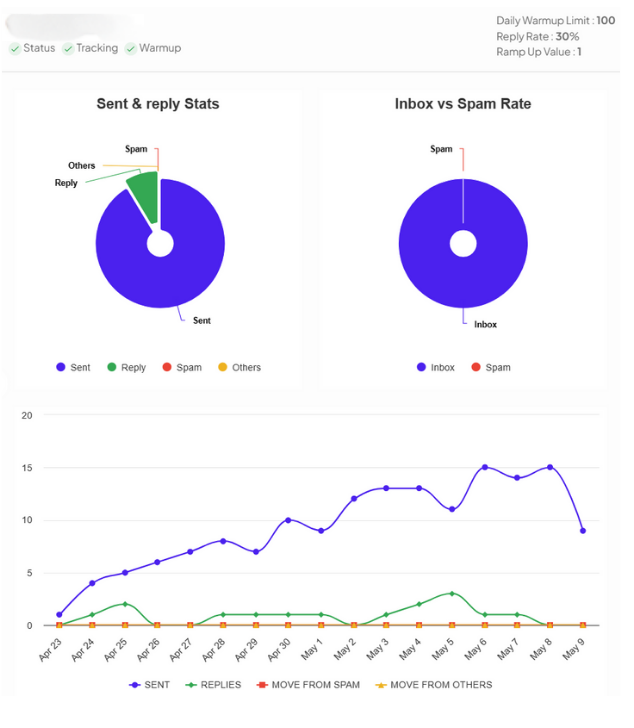
Email warmup analytics in SalesMix
Despite its advanced features and benefits, it remains very accessible price-wise. On its website, you can use its free email warmup calculator to determine the warmup period based on how many emails you plan to send.
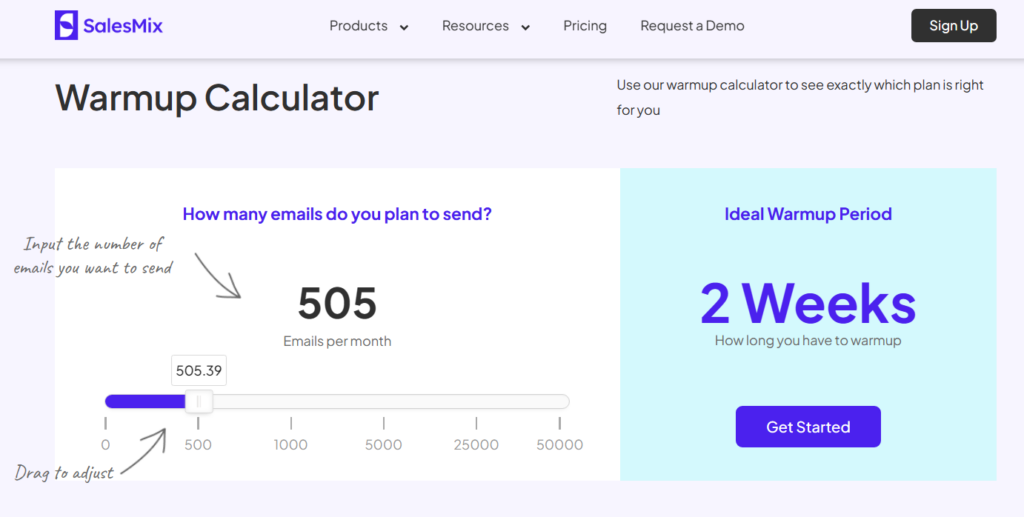
Email warmup period calculation in SalesMix
Mastering the email warmup step can profoundly influence the success of your cold email campaigns. From understanding the meticulous steps of gradually increasing your send volumes to recognizing the importance of high engagement rates, the nuances of email warmup require careful consideration and strategic planning.
If you’re ready to optimize your email strategy and ensure your emails reach and resonate with your audience, consider the steps, factors, and insights shared here as your beginning point. Start your journey with a well-planned email warmup strategy today, and watch as your engagement rates climb and your campaign results flourish.
What is The Cold Email Open Rate & How to Improve It? | SalesMix - Multichannel Sales Automation & Engagement says:
[…] Warming up your email is a critical strategy for anyone embarking on a cold email marketing campaign. This process involves gradually increasing the volume of emails sent from a new email account or domain to build a solid sender reputation. […]
Why are My ConvertKit Emails Going to Spam? | SalesMix - Multichannel Sales Automation & Engagement says:
[…] emails consistently land in the spam folder, one crucial factor to consider is the insufficient warmup of your email account. Without a proper warmup schedule, there's a high likelihood that your emails will get spam […]
How do You Send 10000 Emails From Gmail at Once? - SalesMix - Multichannel Sales Automation & Engagement says:
[…] launching a massive email campaign, it’s critical to warm up your multiple email accounts. SalesMix provides an automated warm-up feature, which is crucial for […]
Gmail SMTP Settings: Easy Setup & Configuration Guide - SalesMix - Multichannel Sales Automation & Engagement says:
[…] SalesMix is a solid tool that can help you enhance the effectiveness of cold email campaigns. A crucial aspect of setting it up involves adding your email accounts for the email warmup. […]